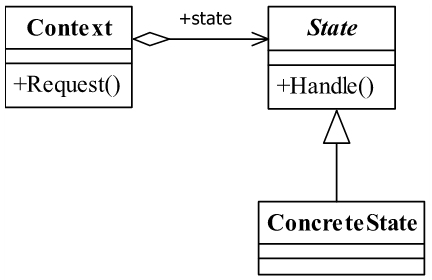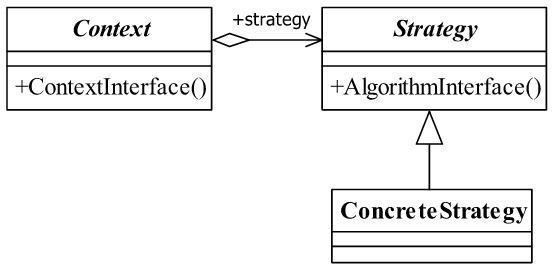状态模式
在状态模式中, 类的行为时给予它的状态改变的。折中类型的设计模式属于行为型模式。
定义
当一个对象内在状态改变时允许其改变行为,这个对象看起来像改变了其类。

实现
抽象状态角色State
接口或者抽象类,负责对象状态的定义,并且封装环境角色以实现状态切换。
1
2
3
4
5
6
7
8
9
10
11
12
13
| public interface IState {
void open();
void close();
void run();
void stop();
}
public abstract class BaseState implements IState {
protected Car context;
public void setContext(Car context) {
this.context = context;
}
}
|
具体状态角色ConcreteState
每个具体状态必须完成两个职责:本状态下要做的事情以及本状态如何过渡到其他状态。
1
2
3
4
5
6
7
8
9
10
11
12
13
14
15
16
17
18
19
20
21
22
23
24
25
26
27
28
29
30
31
32
33
34
35
36
37
38
39
40
41
42
43
44
45
46
47
48
49
50
51
52
53
54
55
56
57
58
59
60
61
62
63
64
65
66
67
68
69
70
71
| public class OpenState extends BaseState {
public void open() {
super.context.setCurrentState(Car.OPEN_STATE);
System.out.println("车门已开启");
}
public void close() {
super.context.setCurrentState(Car.CLOSE_STATE);
System.out.println("关闭车门。。。");
}
public void run() {
System.out.println("开门状态下不允许飙车start");
}
public void stop() {
System.out.println("开门状态下不允许飙车Stop");
}
}
public class StopState extends BaseState {
public void open() {
super.context.setCurrentState(Car.OPEN_STATE);
System.out.println("停车后开启车门");
}
public void close() {
super.context.setCurrentState(Car.CLOSE_STATE);
System.out.println("停车后关闭车门");
}
public void run() {
super.context.setCurrentState(Car.RUN_STATE);
System.out.println("停车后再次跑起来");
}
public void stop() {
super.context.setCurrentState(Car.STOP_STATE);
System.out.println("停车后。。停止不同");
}
}
public class RunState extends BaseState {
public void open() {
System.out.println("飙车时不能开门");
}
public void close() {
System.out.println("飙车时车门已关闭");
}
public void run() {
super.context.setCurrentState(Car.RUN_STATE);
System.out.println("飙车Run");
}
public void stop() {
super.context.setCurrentState(Car.STOP_STATE);
System.out.println("飙车 stop");
}
}
public class CloseState extends BaseState {
public void open() {
super.context.setCurrentState(Car.OPEN_STATE);
System.out.println("开启车门。。。");
}
public void close() {
System.out.println("车门已经关闭!");
}
public void run() {
this.context.setCurrentState(Car.RUN_STATE);
System.out.println("汽车开始运行。。。");
}
public void stop() {
this.context.setCurrentState(Car.STOP_STATE);
System.out.println("汽车停止。");
}
}
|
环境角色Context
定义客户端需要的接口,并且负责具体状态的切换。
把状态对象声明为静态常量,有几个状态对象就声明几个静态常量。
环境角色具有状态抽象角色定义的所有行为,具体执行使用委托方式。
1
2
3
4
5
6
7
8
9
10
11
12
13
14
15
16
17
18
19
20
21
22
23
24
25
26
27
28
29
30
31
| public class Car implements IState {
public static final BaseState OPEN_STATE = new OpenState();
public static final BaseState CLOSE_STATE = new CloseState();
public static final BaseState RUN_STATE = new RunState();
public static final BaseState STOP_STATE = new StopState();
private BaseState currentState;
public Car() {
this.setCurrentState(CLOSE_STATE);
}
public BaseState getCurrentState() {
return currentState;
}
public Car setCurrentState(BaseState currentState) {
this.currentState = currentState;
this.currentState.setContext(this);
return this;
}
public void open() {
this.currentState.open();
}
public void close() {
this.currentState.close();
}
public void run() {
this.currentState.run();
}
public void stop() {
this.currentState.stop();
}
}
|
使用
结合建造者模式将已有的状态按照一定的顺序再重新组装。
1
2
3
4
5
6
7
8
9
10
11
12
13
14
| Car car = new Car();
car.setCurrentState(Car.CLOSE_STATE);
car.run();
car.stop();
car.run();
car.open();
car.stop();
car.open();
car.close();
|
应用
优点
- 结构清晰
避免过多的switch case和if else,降低了程序的复杂性,提高系统的可维护性。
- 遵循设计原则
遵循了开闭原则以及单一职责原则,每个状态都是一个子类,要增加状态就要增加子类,修改状态时只修改一个子类即可。
- 封装性良好
状态变换防止到类的内部来实现,外部调用不需要知道类内部如何实现状态和行为的变换。
缺点
使用场景
- 行为跟随状态改变而改变的场景
- 条件、分支判断语句的替代

